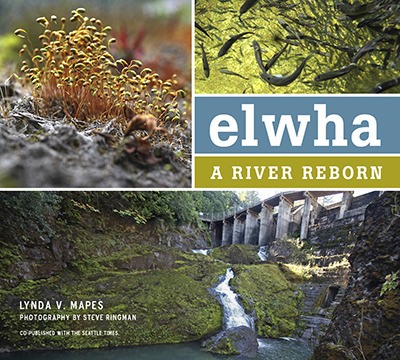Islanders can celebrate a monumental environmental victory that is also, quite literally, a fish story, at a reading tonight.
Lynda Mapes, an award-winning journalist and author, will appear at 7 p.m. Thursday, May 23, at the Land Trust Building, to read from her new book, “Elwha: A River Reborn” — a much-heralded account of the recent dismantling of two massive dams on the Olympic Peninsula’s Elwha River and the subsequent return of chinook and steelhead salmon to that waterway.
The book, co-published by The Mountaineers and The Seattle Times, is based on extensive interviews, field work, historical research and rare period images. The book also contains 125 color photographs by Mapes’ collaborator, Seattle Times photojournalist Steve Ringman. Slides of many of those photographs will be shown during Mapes’ presentation on Vashon.
For Mapes, a Seattle Times reporter, telling the complex tale of the river’s restoration on both the pages of her newspaper and in her book has been the chance of a lifetime.
“The story had everything — it had characters, setting, history, politics, and it had unanswered questions,” Mapes said in a phone interview. “And then it also turned out to be a story against type, of a place that has renewal and hope and something positive.”
The dams — one of them 108 feet tall and the other 210 feet tall, and both within the boundaries of the Olympic National Park — were built and became operational in the years between 1910 and 1927. In the 1980s, members of the Lower Elwha Kallam tribe and environmentalists petitioned for their removal, setting the stage for a three-decades-long struggle among policy and law makers, tribal leaders, conservationists, industrialists and lawyers as to how to best accomplish the job of freeing the river.
In the end, Mapes said, it was everyday people who brought the dams down.
“It was very clear to me how many times this almost didn’t happen,” she said. “But the tribe and ordinary citizens just insisted that this be done.”
To cover the Elwha story, Mapes spent years traveling the back country of the Olympics, immersing herself in the history and culture of the region, as well as gaining deep knowledge of the science of the river itself. From the start, she said, The Seattle Times was committed to fully covering the story of the destruction of the dams — support she was grateful for throughout her years of reporting on the subject.
Mapes’ beat as a reporter includes Native American tribes, nature and environmental topics, and she has received national and regional awards for her work. Along with her teammates on the Elwha coverage at The Seattle Times, she shared the 2012 award for online journalism from the American Association for the Advancement of Science. She is also the author of two other books, “Washington: The Spirit of the Land” and “Breaking Ground.” And earlier this month, she was named as a Knight Science Journalism Fellow — part of an elite class of 12 international journalists who will study science, health, environment and technology at Massachusetts Institute of Technology during the next academic year.
Joseph Bogaard, president of the Vashon Maury Island Land Trust and deputy director of the Northwest organization Save Our Wild Salmon, said he is excited to welcome Mapes back to the island — a place she lived from 1992 to 2002 — to share her book. The land trust is co-sponsoring the author event with Vashon Bookshop, where copies of Mapes’ book are available.
“This is a story that will be told from various angles for a long time,” Bogaard said. “This is happening in our backyard, and we’ve never taken out dams this big on the planet, and the river’s headwaters are deep in a national park that is in pristine condition. It’s a very historic event with lots of historic implications.”



